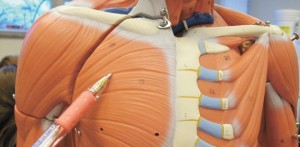“Doc I was bench pressing and it sounded like ripping Velcro.”
By Matthew Stiebel, MD, FRCSC
 Right up there with bulging biceps, the pec muscles are a coveted symbol of masculinity. With a ripple or a bounce, they say, “Hey baby, I work out,” and give men the literal “He-Man” or “Ken” doll action figure physique. For this reason, most workouts focus a portion of their routines on developing the chest.
Right up there with bulging biceps, the pec muscles are a coveted symbol of masculinity. With a ripple or a bounce, they say, “Hey baby, I work out,” and give men the literal “He-Man” or “Ken” doll action figure physique. For this reason, most workouts focus a portion of their routines on developing the chest.
The pectoralis major muscles (the pecs) are the largest portion of the upper chest. They are responsible for push off (think bench press or offensive football linemen) and for adduction and internal rotation of the upper arm (think chest flys or bear hugs.) They originate from both the sternum and the clavicle, and insert on the proximal humerus bone.
Most of the time, the pec muscle tears away from the humerus with an activity that overstresses the muscle, such as bench pressing with large amounts of weight. Often at the bottom of the bench press, when the bar is closest to the chest and the muscles are most under tension/ maximal stretch, the force necessary to begin push off (generated by the firing muscle) overwhelms the tendon that connects the muscle to the bone.
For this reason, most tears of the pectoralis major happen at the level of the tendon attachment- and happen when lifting weights that overstress the muscle. These tears can obviously happen with other traumas that simulate these exercises- such as in a wrestling match, or when trying to control a kicking fire hose, or even with falls that violently rip at the arm. Additionally, some tears are within the muscle belly and not at the tendon junction, but these are somewhat less common.
Interestingly, my practice has seen an increase in frequency of these injuries for what I suspect are two reasons. 1. Most orthopaedic surgeons do not routinely fix these injuries (so these patients are referred to me.) 2. The increase in testosterone and HGH use in our population has lead to some exceptionally strong, enhanced muscles with tendons that cannot match performance.
Once a pec muscle tears away from its tendinous attachment, it often retracts towards the center of the chest. This deformity is most noticeable with attempted flexion of the pec. Additionally, the arm on the affected side is noticeably weaker with all activities that utilize the torn muscle. Down the road, the muscle may also atrophy or cramp.
Surgery to reconstruct the pec muscle is aimed at recreating the normal anatomy. This means that we have to free the muscle up from all the scar tissue. (And these tears lead to a lot of bleeding and scarring) and re-attach it back to the humerus bone by tying it through tunnels created in the bone. Sometimes we have to use additional graft to bridge the gap created by chronic or heavily retracted tears, and for this I often chose hamstring tendon grafts (usually from a donor).
Aside from neurovascular injury, or graft failure, the greatest risk of this operation is clearly infection. One series from Boston saw an infection rate of almost 15%. Whenever an operation takes place in the armpit—infection is a significant concern.
Overall, most patients with successful operations get about 95% of their strength back if they have the surgery near the time of the injury. This means that they can go back to the gym to continue “body sculpting” or return to heavy manual labor—but not until six months or more of healing.
In conclusion, pec tears are a significant injury to a large muscle. They result in loss of function and aesthetic deformity. Fixing them, in turn, requires a significantly large surgery, with a long rehab period. For this reason, some people go about their lives without ever getting the injury repaired. Having read this article, you will now be able to pick out shirt-less actors and WWE wrestlers with pec tears. They simply refrain from bench-press or push-ups and learn to live with an asymmetrical chest. If, however, your career or your hobby involves heavy pec use, or you simply cannot live without a perfectly over-developed set of “chesticles” then you can come see me for repair.
Matthew Stiebel, M.D. FRCSC
Board Certified, Fellowship Trained Orthopaedic Surgeon
Matthew Stiebel, MD FRCSC, is the newest partner at Palm Beach Sportsmedicine. After un-
dergraduate and medical school degrees at Yale University, he completed an orthopaedic surgery residency at McGill University and a subspecialty fellowship in sports medicine at Boston University. His specialties include complex shoulder and knee injuries. Dr Stiebel has published papers and book chapters on specialty surgeries of the knee and shoulder. He is an associate master instructor for the Arthroscopy Asscociation of North America, where he instructs both arthrocopic shoulder and patellofemoral knee courses for surgeons in the US and internationally. He has lectured to the International Patellofemoral Reseach Group in London and New York City, and has worked with patellofemoral implant design companies. His other current interest involves the repair of pectoralis major muscle tears and their subsequent outcomes. While in Montreal, Dr Stiebel worked with the Montreal Canadians Hockey team and Expos Baseball team. During his fellowship time in Boston he was able to serve as team physician for the NCAA championship BU men’s hockey team, UMASS Boston Hockey, as well as work with the World Wrestling Entertainment Summer Slam Series. Locally, Dr Stiebel stays active in the community by currently serving as team physician for some of the local high school football and gymnastics programs.
Certificates/Memberships:
– Board Certification: American Board of Orthopaedic Surgery, July 2012
– American Academy of Orthopaedic Surgeons
– Fellow, Royal College of Physicians and Surgeons of Canada American Arthroscopy Association of North America
– International Society of Arthrosocopy, Knee
Surgery & Orthopaedic Sports Medicine
– International Patellofemoral Reseach Group
 South Florida Health and Wellness Magazine Health and Wellness Articles
South Florida Health and Wellness Magazine Health and Wellness Articles




